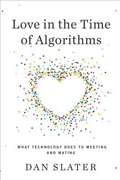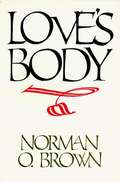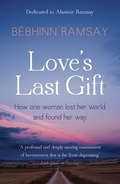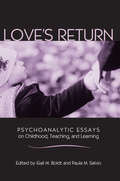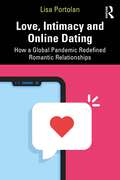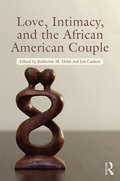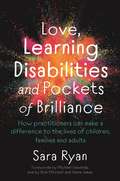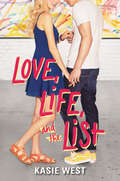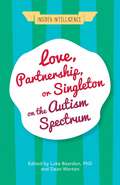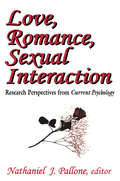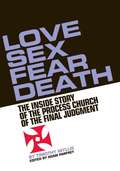- Table View
- List View
Love in the Time of Algorithms
by Dan Slater“If online dating can blunt the emotional pain of separation, if adults can afford to be increasingly demanding about what they want from a relationship, the effect of online dating seems positive. But what if it’s also the case that the prospect of finding an ever more compatible mate with the click of a mouse means a future of relationship instability, a paradox of choice that keeps us chasing the illusive bunny around the dating track?” It’s the mother of all search problems: how to find a spouse, a mate, a date. The escalating marriage age and declining marriage rate mean we’re spending a greater portion of our lives unattached, searching for love well into our thirties and forties. It’s no wonder that a third of America’s 90 million singles are turning to dating Web sites. Once considered the realm of the lonely and desperate, sites like eHarmony, Match, OkCupid, and Plenty of Fish have been embraced by pretty much every demographic. Thanks to the increasingly efficient algorithms that power these sites, dating has been transformed from a daunting transaction based on scarcity to one in which the possibilities are almost endless. Now anyone—young, old, straight, gay, and even married—can search for exactly what they want, connect with more people, and get more information about those people than ever before. As journalist Dan Slater shows, online dating is changing society in more profound ways than we imagine. He explores how these new technologies, by altering our perception of what’s possible, are reconditioning our feelings about commitment and challenging the traditional paradigm of adult life. Like the sexual revolution of the 1960s and ’70s, the digital revolution is forcing us to ask new questions about what constitutes “normal”: Why should we settle for someone who falls short of our expectations if there are thousands of other options just a click away? Can commitment thrive in a world of unlimited choice? Can chemistry really be quantified by math geeks? As one of Slater’s subjects wonders, “What’s the etiquette here?” Blending history, psychology, and interviews with site creators and users, Slater takes readers behind the scenes of a fascinating business. Dating sites capitalize on our quest for love, but how do their creators’ ideas about profits, morality, and the nature of desire shape the virtual worlds they’ve created for us? Should we trust an industry whose revenue model benefits from our avoiding monogamy? Documenting the untold story of the online-dating industry’s rise from ignominy to ubiquity—beginning with its early days as “computer dating” at Harvard in 1965—Slater offers a lively, entertaining, and thought provoking account of how we have, for better and worse, embraced technology in the most intimate aspect of our lives. .
Love in the Time of Algorithms
by Dan Slater"If online dating can blunt the emotional pain of separation, if adults can afford to be increasingly demanding about what they want from a relationship, the effect of online dating seems positive. But what if it's also the case that the prospect of finding an ever more compatible mate with the click of a mouse means a future of relationship instability, a paradox of choice that keeps us chasing the illusive bunny around the dating track?" It's the mother of all search problems: how to find a spouse, a mate, a date. The escalating marriage age and declining marriage rate mean we're spending a greater portion of our lives unattached, searching for love well into our thirties and forties. It's no wonder that a third of America's 90 million singles are turning to dating Web sites. Once considered the realm of the lonely and desperate, sites like eHarmony, Match, OkCupid, and Plenty of Fish have been embraced by pretty much every demographic. Thanks to the increasingly efficient algorithms that power these sites, dating has been transformed from a daunting transaction based on scarcity to one in which the possibilities are almost endless. Now anyone--young, old, straight, gay, and even married--can search for exactly what they want, connect with more people, and get more information about those people than ever before. As journalist Dan Slater shows, online dating is changing society in more profound ways than we imagine. He explores how these new technologies, by altering our perception of what's possible, are reconditioning our feelings about commitment and challenging the traditional paradigm of adult life. Like the sexual revolution of the 1960s and '70s, the digital revolution is forcing us to ask new questions about what constitutes "normal": Why should we settle for someone who falls short of our expectations if there are thousands of other options just a click away? Can commitment thrive in a world of unlimited choice? Can chemistry really be quantified by math geeks? As one of Slater's subjects wonders, "What's the etiquette here?" Blending history, psychology, and interviews with site creators and users, Slater takes readers behind the scenes of a fascinating business. Dating sites capitalize on our quest for love, but how do their creators' ideas about profits, morality, and the nature of desire shape the virtual worlds they've created for us? Should we trust an industry whose revenue model benefits from our avoiding monogamy? Documenting the untold story of the online-dating industry's rise from ignominy to ubiquity--beginning with its early days as "computer dating" at Harvard in 1965--Slater offers a lively, entertaining, and thought provoking account of how we have, for better and worse, embraced technology in the most intimate aspect of our lives.
Love in the Time of Contagion: A Diagnosis
by Laura KipnisIn this timely, insightful, and darkly funny investigation, the acclaimed author of Against Love asks: what does living in dystopic times do to our ability to love each other and the world?COVID-19 has produced new taxonomies of love, intimacy, and vulnerability. Will its cultural afterlife be as lasting as that of HIV, which reshaped consciousness about sex and love even after AIDS itself had been beaten back by medical science? Will COVID end up making us more relationally conservative, as some think HIV did within gay culture? Will it send us fleeing into emotional siloes or coupled cocoons, despite the fact that, pre-COVID, domestic coupledom had been steadily losing fans? Just as COVID revealed our nation to itself, so did it hold a mirror up to our own relationships. In Love in the Time of Contagion, Laura Kipnis weaves (often hilariously) her own (ambivalent) coupled lockdown experiences together with those of others, and sets them against a larger backdrop: the politics of the virus, economic disparities, changing gender relations, and the ongoing institutional crack-ups prompted by #MeToo and Black Lives Matter, as she maps their effects on the everyday routines and occasional solaces of love and sex.
Love or Perish [Expanded Edition]
by Dr Smiley BlantonThe New York Times called this famous guide to a more rewarding life “sound and solid, the product of a richly furnished mind, a book of wisdom.” Written by one of America’s most distinguished psychiatrists, Dr. Smiley Blanton, it has already found its way into some 200,000 American homes. Hundreds of readers have written to the author saying they were helped, inspired—and wanted more.In response to these letters, Dr. Blanton added an enormously valuable new section showing how men and women of all ages can give themselves as second chance at happiness—this section, titled “On Making a Fresh Start,” is included in this Expanded Edition, which was first published in 1957.“I believe that it is possible to achieve an emotional change with the insight developed through books. Books can make a change in one’s philosophy and attitude toward life. That is why so many books of the world are so deeply cherished.“It is in this hope that I write, in an effort to bring to people the hard-won truths of my observation over many years of life and during more than forty years of practice in psychiatry.”—Dr. Smiley Blanton, Introduction
Love the Wild Swan: The selected works of Judith Edwards (World Library of Mental Health)
by Judith EdwardsLove the Wild Swan is the culmination of thirty years of clinical and teaching experience, undertaken by child and adolescent psychoanalytic psychotherapist Judith Edwards. Along with new material, the book consists of previously published papers spanning Edwards’s entire career, which have been carefully selected to chart the journey that every clinician and human being makes, from babyhood to adult life. Edwards offers an example of how the evolution of meanings occur and how lifelong learning about the self and the other takes place. The book is divided into four parts, with sections on observation, clinical work, teaching theory, and links between these ideas and ongoing life in the form of the arts, through poetry, film and sculpture. Love the Wild Swan will be of interest to practitioners and clinicians, as well as appealing to anyone in the field of mental health who wishes to reflect on the nature of human development and growth.
Love to Learn: The Transformative Power of Care and Connection in Early Education
by Isabelle C. HauThe most important aspect of early childhood in general and education in particular is the quality and care of the relationships a child forms. Love to Learn shows how to build and develop these relationships -- and unlock every child's true potential. Early relationships are the key to healthy brain development, resilience, and lifelong flourishing. Children need to be loved, to be valued, to interact, and to be listened to. When children have the space and time to play and explore through nurturing positive relationships, then children learn. But loving relationships are precisely what so many children are missing, and modern factors are making it more difficult for children to build these necessary bonds. Kids are growing up in smaller families with fewer siblings, and in more single-parent households. They have fewer adult family friends and mentors. They have less contact with grand-parents and grand-adults. They spend 60% less time with friends than children did a decade ago. They play outside less—half the time spent by their parent&’s generation. They find themselves increasingly immersed in solitary realms of screens, a modern sanctuary where parents seek refuge as well. Many kids are so overscheduled they have less time to build friendships Love to Learn offers a vision for a future where learning is relational, and love is a literacy. It is a provocative paradigm shift, from child-centered education to relationship-centered learning. It weaves in stories of perseverance, empathy, creativity, and showcases innovations anchored in the latest neuroscience and technology advance – all driven by the desire to unlock the inherent human potential in any child. This hope-filled book seeks to change how we raise our children, how we run early learning environments, and how we construct care-full communities. It aims to inspire and engage readers, catalyze new solutions, and in doing so, change our understanding of childhood itself.
Love's Body
by Norman O. BrownOriginally published in 1966 and now recognized as a classic, Norman O. Brown's meditation on the condition of humanity and its long fall from the grace of a natural, instinctual innocence is available once more for a new generation of readers. Love's Body is a continuation of the explorations begun in Brown's famous Life Against Death. Rounding out the trilogy is Brown's brilliant Apocalypse and/or Metamorphosis.
Love's Executioner: & Other Tales of Psychotherapy
by Irvin D. YalomThe collection of ten absorbing tales by master psychotherapist Irvin D. Yalom uncovers the mysteries, frustrations, pathos, and humor at the heart of the therapeutic encounter. In recounting his patients' dilemmas, Yalom not only gives us a rare and enthralling glimpse into their personal desires and motivations but also tells us his own story as he struggles to reconcile his all-too human responses with his sensibility as a psychiatrist. Not since Freud has an author done so much to clarify what goes on between a psychotherapist and a patient.
Love's Last Gift
by Bebhinn RamsayIn May 2007, while on a family holiday, Bébhinn Ramsay's husband Alastair woke in the middle of the night with a fever. Just over forty-eight hours later, he died in hospital from a rare complication to a common infection. At the age of thirty-one, Bébhinn had not only lost her soulmate and the father of her two young sons, but also her faith in life.In this captivating memoir of hope, courage and eternal love, we journey with Bébhinn as she searches for answers and a sense of meaning to her husband's untimely death, and discover how she comes to find peace and happiness by opening her mind and her heart.
Love's Last Gift
by Bebhinn RamsayIn May 2007, while on a family holiday, Bébhinn Ramsay's husband Alastair woke in the middle of the night with a fever. Just over forty-eight hours later, he died in hospital from a rare complication to a common infection. At the age of thirty-one, Bébhinn had not only lost her soulmate and the father of her two young sons, but also her faith in life.In this captivating memoir of hope, courage and eternal love, we journey with Bébhinn as she searches for answers and a sense of meaning to her husband's untimely death, and discover how she comes to find peace and happiness by opening her mind and her heart.
Love's Next Meeting: The Forgotten History of Homosexuality and the Left in American Culture
by Aaron LeckliderHow queerness and radical politics intersected—earlier than you thought. Well before Stonewall, a broad cross section of sexual dissidents took advantage of their space on the margins of American society to throw themselves into leftist campaigns. Sensitive already to sexual marginalization, they also saw how class inequality was exacerbated by the Great Depression, witnessing the terrible bread lines and bread riots of the era. They participated in radical labor organizing, sympathized like many with the early prewar Soviet Union, contributed to the Republicans in the Spanish Civil War, opposed US police and state harassment, fought racial discrimination, and aligned themselves with the dispossessed. Whether they were themselves straight, gay, or otherwise queer, they brought sexual dissidence and radicalism into conversation at the height of the Left's influence on American culture. Combining rich archival research with inventive analysis of art and literature, Love’s Next Meeting explores the relationship between homosexuality and the Left in American culture between 1920 and 1960. Aaron S. Lecklider uncovers a lively cast of individuals and dynamic expressive works, revealing remarkably progressive engagement with homosexuality among radicals, workers, and the poor. Leftists connected sexual dissidence with radical gender politics, antiracism, and challenges to censorship and obscenity laws through the 1920s and 1930s. In the process, a wide array of activists, organizers, artists, and writers laid the foundation for a radical movement through which homosexual lives and experiences were given shape and new political identities were forged. Love's Next Meeting cuts to the heart of some of the biggest questions in American history: questions about socialism, about sexuality, about the supposed clash still making headlines today between leftist politics and identity politics. What emerges is a dramatic, sexually vibrant story of the shared struggles for liberation across the twentieth century.
Love's Refraction
by Jillian DeriPopular wisdom might suggest that jealousy is an inevitable outcome of non-monogamous relationships. In Love's Refraction, Jillian Deri explores the distinctive question of how and why polyamorists - people who practice consensual non-monogamy - manage jealousy. Her focus is on the polyamorist concept of "compersion" - taking pleasure in a lover's other romantic and sexual encounters.By discussing the experiences of queer, lesbian, and bisexual polyamorous women, Deri highlights the social and structural context that surrounds jealousy. Her analysis, making use of the sociology of emotion and feminist intersectionality theory, shows how polyamory challenges traditional emotional and sexual norms.Clear and concise, Love's Refraction speaks to both the academic and the polyamorous community. Deri lets her interviewees speak for themselves, linking academic theory and personal experiences in a sophisticated, engaging, and accessible way.
Love's Return: Psychoanalytic Essays on Childhood, Teaching, and Learning
by Paula M. Salvio Gail M. BoldtThe idea that teachers love children is often taken for granted in education. Rarely is the idea of love itself examined. Bringing together the work of educators, curriculum theorists and clinical psychoanalysts, and drawing upon autobiographical and narrative case studies, this groundbreaking collection examines the collision of love and learning, including the ways in which such intersections are provoked, repressed and denied. Contributors turn to psychoanalysis to explore questions of love in all of its varying permutations - ambivalence, sexuality, hatred, desire, projection, and loss - in order to demonstrate how the social ramifications of such work is critical to the ways teachers are currently being prepared for life in the classroom.
Love, Fear, and Health
by Robert Maunder Jonathan HunterCan the way in which we relate to others seriously affect our health? Can understanding those attachments help health care providers treat us better? In Love, Fear, and Health, psychiatrists Robert Maunder and Jonathan Hunter draw on evidence from neuroscience, stress physiology, social psychology, and evolutionary biology to explain how understanding attachment - the ways in which people seek security in their close relationships - can transform patient outcomes.Using attachment theory, Maunder and Hunter provide a practical, clinically focused introduction to the influence of attachment styles on an individual's risk of disease and the effectiveness of their interactions with health care providers. Drawing on more than fifty years of combined experience as health care providers, teachers, and researchers, they explain in clear language how health care workers in all disciplines can use this knowledge to meet their patients' needs better and to improve their health.
Love, Hate and Knowledge: The Kleinian Method and the Future of Psychoanalysis
by Robert WaskaThis book introduces the clinical concept of analytic contact. This is a term that describes the therapeutic method of investigation that makes up psychoanalytic treatment. The field has been in debate for decades regarding what constitutes psychoanalysis. This usually centers on theoretical ideals regarding analyzability, goals, or procedure and external criteria such as frequency or use of couch. Instead, the concept of analytic contact looks at what takes place with a patient in the clinical situation. Each chapter in this book follows a wide spectrum of cases and clinical situations where hard to reach patients are provided the best opportunity for health and healing through the establishment of analytic contact. This case material closely tracks each patient's phantasies, and transference mechanisms which work to either increase, oppose, embrace, or neutralize, analytic contact. In addition, the fundamental internal conflicts all patients struggle with between love, hate, and knowledge are represented by extensive case reports.
Love, Intimacy and Online Dating: How a Global Pandemic Redefined Romantic Relationships
by Lisa PortolanLove, Intimacy and Online Dating: How a Global Pandemic Redefined Romantic Relationships is an innovative work that explores the concept of intimacy during the COVID-19 pandemic. The book provides an overview of the online dating world and apps, the use of which gradually became common as the pandemic restricted people’s interaction in the physical world. The author’s extensive research conducted during the pandemic posits a comprehensive understanding of the individual’s motivation to join a dating app and explores its varied aspects. This thoroughly researched book explores the themes and elements of online dating and examines the users’ motivation for joining a dating app, for seeking intimacy as well as for self-presentation on the app. Portolan examines the underlying politics and role of infrastructure of dating apps and describes how gender, power, and intimacy intersect to create new intimacy phenomena. She also utilises her research to put forth the key concept of "Jagged Love", which describes a user’s cyclical relationship with dating apps during the pandemic, and the gap between a user’s act to seek familiar romantic narratives and the app’s inability to deliver against these ideas. The chapters further explore the differences between virtual and In Real Life (IRL) intimacy, the generation of gender and the emanation of stereotypical cultural ideals that the users sought through the apps. The book serves as an invaluable discussion on the pandemic’s impact on modifying the definitions of romance and intimacy. This book will be useful for highlighting the impact social factors can have on familiar concepts and the effects of the COVID-19 pandemic on the definition of love and intimacy, making it fascinating for students, academics and professionals interested in relationships, digital media and gender. It will also be useful in enhancing the comprehension of love and romance in the fields of social science.
Love, Intimacy, and the African American Couple (Routledge Series on Family Therapy and Counseling)
by Jon Carlson Katherine M. HelmThis exciting new text on counseling African American couples outlines critical components to providing culturally-sensitive treatment. Built around a framework that examines African American couples’ issues as well as the specific contextual factors that can negatively impact their relationships, it:• Addresses threats to love and intimacy for Black couples• Provides culturally relevant, strengths-based approaches and assessment practices• Includes interesting case studies at the conclusion of each chapter that illustrate important concepts.The chapters span the current state of couple relationships; readers will find information for working with lesbians and gays in relationships, pastoral counseling, and intercultural Black couples. There is also a chapter for non-Black therapists who work with Black clients. Dispersed throughout the book are interviews with prominent African American couples’ experts: Dr. Chalandra Bryant, relationship expert Audrey B. Chapman, Dr. Daryl Rowe and Dr. Sandra Lyons-Rowe, and Dr. Thomas Parham. They provide personal insight on issues such as the strengths African Americans bring to relationships, their skills and struggles, and gender and class considerations. This must-read book will significantly help you and your clients.
Love, Learning Disabilities and Pockets of Brilliance: How Practitioners Can Make a Difference to the Lives of Children, Families and Adults
by Sara RyanFind some pockets of brilliance for your practice! Insights and inspiration from families of learning disabled people, who share their lives, challenges and wishes. Discover what sorts of help will really help the people you support.
Love, Life, and the List
by Kasie WestWhat do you do when you’ve fallen for your best friend? Funny and romantic, this effervescent story about family, friendship, and finding yourself is perfect for fans of Sarah Dessen and Jenny Han.Seventeen-year-old Abby Turner’s summer isn’t going the way she’d planned. She has a not-so-secret but definitely unrequited crush on her best friend, Cooper. She hasn’t been able to manage her mother’s growing issues with anxiety. And now she’s been rejected from an art show because her work “has no heart.” So when she gets another opportunity to show her paintings, Abby isn’t going to take any chances.Which is where the list comes in.Abby gives herself one month to do ten things, ranging from face a fear (#3) to learn a stranger’s story (#5) to fall in love (#8). She knows that if she can complete the list, she’ll become the kind of artist she’s always dreamed of being.But as the deadline approaches, Abby realizes that getting through the list isn’t as straightforward as it seems . . . and that maybe—just maybe—she can’t change her art if she isn’t first willing to change herself.
Love, Loyalty and Deceit: Rosemary Firth, a Life in the Shadow of Two Eminent Men
by Hugh Firth Loulou BrownHow much do we really know about our parents’ lives? What secrets lie in plain sight? This is the true story of hidden love within a small circle of some of the most acclaimed anthropologists of the 20th century. Told by Rosemary and Raymond Firth's son, and the daughter of Celia and Edmund Leach, the man Rosemary loved all her life, this part love-story, part biography, part social history is the tale of a highly influential circle of social anthropologists in Britain from the 1930s, through the Second World War, to the end of the century. The book explores their early influences, their insecurities, their flaws, struggles and achievements. It is a story of passion and commitment, but also of deceit and betrayal, including the inexplicable disappearance, death and alleged murder of a very close friend. It also narrates Rosemary's struggles for emotional and intellectual independence in the face of societal expectations of women and her own guilt, loss and self-doubt. From the Prologue: Rosemary loved many people in many different ways, but she loved two men in particular throughout most of her life. One was her husband, Raymond Firth, regarded by some as among the founding fathers of social anthropology. Yet she also retained a passionate devotion to her first love, Edmund Leach, who would subsequently become the public intellectual face of social anthropology in the later 1960s. Both separately and together they were part of the process of defining the nature of this still growing discipline in the first part of the mid-twentieth century.
Love, Mortality and the Moving Image
by Emma WilsonIn their use of home movies, collages of photographs and live footage, moving image artists explore the wish to see dead loved ones living. This study scrutinizes emotions and sensations surrounding mortality and longing. Its focus is on love, tenderness, and eroticism, on the undoing of the self in desire and loss, and on the pursuit of relations with a missing other. In dialogue with Judith Butler on grievability, and Giorgio Agamben on bare life, Emma Wilsontraces connections between imaging of intimate losses and public acts of mourning in response to atrocity, the Shoah and Hurricane Katrina. The book lays out a series of sensitive new readings of works by Agnes Varda, Pedro Almodovar, Ingmar Bergman, Sophie Calle, and many others. Attending to images of tactility, to fine details of texture, light, and affect, it re-imagines the role of the sensuous in lens-based art. "
Love, Partnership, or Singleton on the Autism Spectrum
by David Walsh David Smith Alexandra Brown Christopher Wilson Dean Worton Luke Beardon Philip Bricher A. Nonny Mouse Alex Wilkinson Alyssa Aleksanian Anthony Sclafani Atul Movelis C. A. Smart Chris Stobart Elizabeth Wady Freddie Gwen Greenwood Joanna Treasure Joseph Edmonds Jules Lacey Kerr Lynette Marshall Norman Bridge P. J. Hughes Paul Wady Planet Autism Sandra Beale-Ellis Tracy Turner Wenn LawsonIn an immensely varied and thoughtful collection of true life reflections on love, marriage and the single life, 26 authors with autism share their experiences and knowledge about successful (and unsuccessful) relationships. Digging deep into the many and varying ways in which autism affects feelings and relationships with others, these honest and intelligent testimonies give the insider's perspective on love on the spectrum. Whether you're a serial dater, hopelessly romantic or happily single, these perceptive and often funny explorations shows how to make good choices, surmount bad ones, and live a good life.
Love, Romance, Sexual Interaction: Research Perspectives from "Current Psychology"
by Nathaniel PalloneThis volume brings together in a single resource fourteen empirical studies examining a variety of emotions and behaviors covering many aspects of love, romance, and sexual interaction from recent issues of Current Psychology. Scholars from universities and research centers bring under the empiricist's microscope a variety of emotions and behaviors, ranging from dating relationships, criteria for the ideal mate held by both men and women, the relationship between perceptions of parents and partners in a direct test of psychoanalytic conceptualizations of mate selection, how the media influence perceptions about love and romance, sources of marital conflict, gender differences in responses to infidelity, and even the attitudes of "consumers" toward prostitution.Contributors and topics of discussion include: Albert Mehrabian and Jeffrey S. Blum, "Physical Appearance, Attractiveness, and the Mediating Effect of Emotions"; Gordon L. Flett, Paul L. Hewitt, Brenley Shapiro, and Jill Rayman, "Perfectionism, Beliefs, and Adjustment in Dating Relationships"; Robert Ervin Cramer, Jeffrey T. Schaefer, and Suzanne Reid, "Identifying the Ideal Mate: More Evidence for Male-Female Convergence"; Glenn Geher, "Perceived and Actual Characteristics of Parents and Partners: A Freudian Model of Mate Selection"; Claudia J. Haferkamp, "Beliefs about Relationships in Relation to Television Viewing, Soap Opera Viewing, and Self-Monitoring"; Blaine J. Flowers and Brooks Applegate, "Marital Satisfaction and Conventionalization Examined Didactically"; Claudia J. Haferkamp, "Dysfunctional Beliefs, Self-Monitoring, and Marital Conflict"; Emily A. Impett, Kristin P. Beals, and Letitia A. Peplau, "Testing the Investment Model of Relationship Commitment and Stability in a Longitudinal Study of Married Couples"; Richard Clements and Clifford H. Swensen, "Commitment to One's Spouse as a Predictor of Marital Quality among Older Couples"; Robert Ervin Cramer, William Todd Abraham, Lesley M. Johnson, Barbara Manning-Ryan, "Gender Differences in Subjective Distress to Emotional and Sexual Infidelity"; William Todd Abraham, Robert Ervin Cramer, Ana Maria Fernandez, and Eileen Mahler, "Infidelity, Race, and Gender"; Ami Rokach, "Strategies of Coping with Loneliness throughout the Lifespan."
Love, Sex and Long-Term Relationships: What People with Asperger Syndrome Really Really Want
by Stephen Shore Sarah HendrickxWhat are the motivations and desires behind relationship choices and sexual behaviour? Are they very different for those with Asperger Syndrome (AS) than for anyone else? Does having extreme sensitivity to physical touch or an above average need for solitude change one's expectation of relationships or sexual experience? Many people on the autism spectrum have limited knowledge of how to establish or conduct sexual relationships: drawing on extensive research with people on the autism spectrum, the book openly explores such questions. For the first time people with AS discuss their desires, needs and preferences in their own words. AS attitudes to issues such as gender, sexual identity and infidelity are included, as well as positive advice for developing relationships and exploring options and choices for sexual pleasure. This accessible book is an invaluable source of information and support for those with Asperger Syndrome and couples in which one or both partners has Asperger Syndrome, as well as counsellors and health and social care professionals.
Love, Sex, Fear, Death
by Timothy Wyllie Adam ParfreyThe Process Church of the Final Judgment was the apocalyptic shadow side of the flower-powered '60s and perhaps the most notorious cult of modern times.Hundreds of black-cloaked devotees, often wearing a satanic "Goat of Mendes" and a swastika-like mandala, swept the streets of London, New York, Boston, Chicago, New Orleans, and Toronto, selling magazines and books with titles like Fear and Humanity is the Devil. And within the group's "Chapters," members would participate in "Midnight Meditations" beneath photographs of the Christ-like leader.Celebrities like Marianne Faithful, James Coburn, and Mick Jagger participated in Process publications, and Funkadelic, in its Maggot Brain album, reprinted Process' "Fear Issue."Process' "Death Issue" interviewed the freshly-imprisoned Charles Manson leading to conspiracy hysteria in such books as Ed Sanders' The Family and Maury Terry's The Ultimate Evil. A lawsuit against Sanders' Manson book led to the removal of its Process-themed chapter by Dutton.Love, Sex, Fear, Death is the shocking, surprising, and secretive inside story of The Process Church, which was later transformed into Foundation Faith of the Millennium, and most recently as the Utah-based animal sanctuary, Best Friends.Included will be text by Timothy Wyllie, a formative member of the Process and Foundation Faith organizations; interviews with other former Processeans; rare reproductions of Process magazines; never-before-seen photographs; and fascinating transcripts from holy books and legal actions.The special limited edition will be hardcover, signed, numbered, and slipcased, and it will include a facsimile edition of the notorious "Death Issue."
